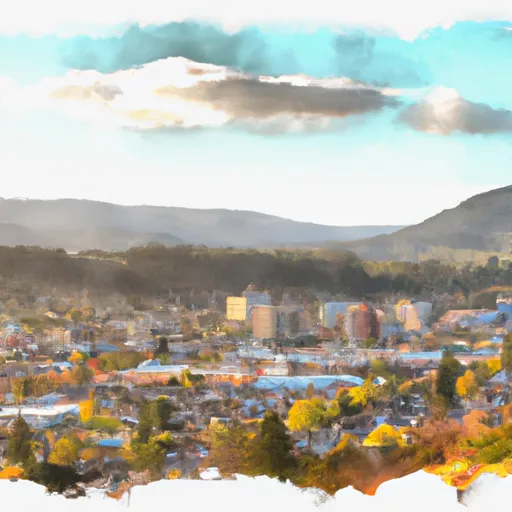-
 Snoflo Premium
Snoflo Premium
Get unlimited access to all our content
With no Ad interruptions! - Start Your Free Trial Login with existing account
White-Salmon
Eden Index
Climate
7.8
•
Recreation
7.3
•
Community
3.4
•
Safeguard
6.5/10

White Salmon is a charming town located in Klickitat County, Washington. Situated in the Columbia River Gorge, the town boasts a captivating natural setting and an array of outdoor recreational opportunities. The climate in White Salmon is classified as a temperate Mediterranean climate, with warm, dry summers and mild, wet winters. The region experiences abundant sunshine throughout the year, making it ideal for outdoor activities.
One of the prominent features of White Salmon is its hydrology constituents, particularly the White Salmon River. The river is known for its thrilling whitewater rapids, attracting rafters and kayakers from far and wide. Additionally, the river offers excellent fishing opportunities, with salmon and steelhead being the prized catch.
Outdoor enthusiasts will find a plethora of activities to indulge in. The area is a haven for hikers and bikers, with numerous trails offering breathtaking views of the surrounding landscapes. Nearby, the Columbia River provides opportunities for windsurfing and kiteboarding, while the towering cliffs of Beacon Rock State Park offer rock climbing adventures.
Overall, White Salmon provides an idyllic setting for nature lovers and adventure seekers, with its favorable climate, beautiful hydrology constituents, and diverse outdoor recreation opportunities.
What is the Eden Index?
The Snoflo Eden Index serves as a comprehensive rating system for regions, evaluating their desirability through a holistic assessment of climate health, outdoor recreation opportunities, and natural disaster risk, acknowledging the profound impact of these factors on livability and well-being.
Climate Health Indicator (CHI): 7.8
White-Salmon receives approximately
808mm of rain per year,
with humidity levels near 82%
and air temperatures averaging around
10°C.
White-Salmon has a plant hardyness factor of
7, meaning
plants and agriculture in this region tend to thrive during the non-winter months.
By considering the ideal temperature range, reliable water supplies, clean air, and stable seasonal rain or snowpacks, the Climate Health Indicator (CHI) underscores the significance of a healthy climate as the foundation for quality living.
A healthy climate is paramount for ensuring a high quality of life and livability in a region, fostering both physical well-being and environmental harmony. This can be characterized by ideal temperatures, reliable access to water supplies, clean air, and consistent seasonal rain or snowpacks.
Weather Forecast
Streamflow Conditions
Middle Columbia
Area Rivers
Middle Columbia
Snowpack Depths
Middle Columbia
Reservoir Storage Capacity
Middle Columbia
Groundwater Levels
Recreational Opportunity Index (ROI): 7.3
The Recreational Opportunity Index (ROI) recognizes the value of outdoor recreational options, such as parks, hiking trails, camping sites, and fishing spots, while acknowledging that climate plays a pivotal role in ensuring the comfort and consistency of these experiences.
Access to outdoor recreational opportunities, encompassing activities such as parks, hiking, camping, and fishing, is crucial for overall well-being, and the climate plays a pivotal role in enabling and enhancing these experiences, ensuring that individuals can engage in nature-based activities comfortably and consistently.
Camping Areas
| Campground | Campsites | Reservations | Toilets | Showers | Elevation |
|---|---|---|---|---|---|
| Guler - Mt. Adams Park | None | 1,932 ft | |||
| Bird Creek - State Forest | 9 | 2,593 ft | |||
| Bench Lake | None | 4,964 ft | |||
| Oklahoma | 23 | 1,749 ft | |||
| Big Cedars Campground | None | 1,356 ft | |||
| Moss Creek | 18 | 1,385 ft | |||
| Morrison Creek | 12 | 4,683 ft | |||
| Yakama Nation - Bench Lake | None | 4,963 ft | |||
| Peterson Prairie | 35 | 3,000 ft | |||
| Bird Lake | None | 5,590 ft |
Nearby Fishing
Nearby Ski Areas
Catastrophe Safeguard Index (CSI):
The Catastrophe Safeguard Index (CSI) recognizes that natural disaster risk, encompassing floods, fires, hurricanes, and tornadoes, can drastically affect safety and the overall appeal of an area.
The level of natural disaster risk in a region significantly affects safety and the overall livability, with climate change amplifying these risks by potentially increasing the frequency and intensity of events like floods, fires, hurricanes, and tornadoes, thereby posing substantial challenges to community resilience and well-being.
Community Resilience Indicator (CRI): 3.4
The Community Resilience Indicator (CRI) recognizes that education, healthcare, and socioeconomics are crucial to the well-being of a region. The CRI acknowledges the profound impact of these elements on residents' overall quality of life. By evaluating educational resources, healthcare accessibility, and economic inclusivity, the index captures the essential aspects that contribute to a thriving community, fostering resident satisfaction, equity, and social cohesion.

